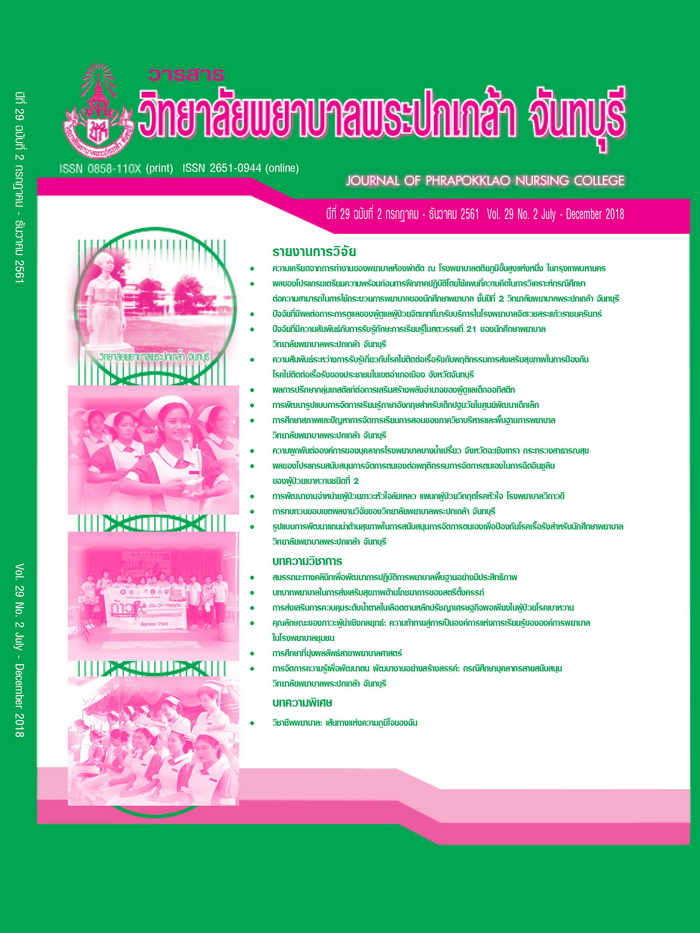A Development of Discharge Planning in Congestive Heart Failure Patients at Vibhavadi Hospital
Keywords:
Discharge planning, Congestive heart failure, Model development, Intensive careAbstract
This experimental development research aimed to develop a new working model of discharge planning in congestive heart failure patients in coronary care unit (CCU) at Vibhavadi Hospital using the existing resources. The samples consisted of 2 groups; one group was the discharge planning activities in an experimental area (17 times) and a control area (13 times), another group was person regarding discharge planning in congestive heart failure patients included administrators, service providers, and clients. The research instruments included a new working model of discharge planning in congestive heart failure patients, four recording forms, one check-list form, and three questionnaires. The implementation and data collection were conducted from 1st June to 31th October, 2014. Content analysis, Mann-Whitney U test, and Wilcoxon signed-rank test were used for data analysis.
The research results revealed that 1) the new working model of discharge planning in congestive heart failure patients has been developed by applying relevant academic concepts and principles; and 2) after model implementation, an experimental area had statistically significant better working results than before model implementation:- the average working quantity increased (p < .01), the accuracy of working performance increased (p < .001), the average service time decreased (p < .001), the average workforce consumed decreased (p < .01), the service providers’ satisfaction increased (p < .01), and unit cost decreased (p < .001).
This research suggests that the health care providers in the coronary care unit should implement this model in congestive heart failure patients in order to ensure that appropriate post-discharges are in place in an effective manner. Furthermore, the nurse administrators should encourage this discharge planning as a guideline to effective hospital discharge in other chronic illness patients.
References
กรมการแพทย์ กระทรวงสาธารณสุข. (2553). สถิติโรค 2553. สืบค้นจาก http://www.dms.moph.go.th
ผ่องพรรณ อรุณแสง. (2552). การพยาบาลผู้ป่วยโรคหัวใจและหลอดเลือด (พิมพ์ครั้งที่ 6). ขอนแก่น: โรงพิมพ์คลังนานาวิทยา.
สมชาติ โตรักษา. (2558). การประยุกต์หลักการบริหารเพื่อการพัฒนางานอย่างต่อเนื่องและยั่งยืน (พิมพ์ครั้งที่ 2). กรุงเทพฯ: ภาควิชาบริหารงานสาธารณสุข คณะสาธารณสุขศาสตร์ มหาวิทยาลัยมหิดล.
Laothavorn, P., Hengrussamee, K., Kanjanavanit, R., Moleerergpoom, W., Laorakpongse, D., Pachirat, O., … Sritara, P. (2010). Thai acute decompensated heart failure registry (Thai ADHERE). CVD Prevention and Control, 5(3), 89-95.
Pang, P. S., Komajda, M., & Gheorghiade, M. (2010). The current and future management of acute heart failure syndromes. European Heart Journal, 31(7), 784-793.
World Health Organization. (2009). Cardiovascular_diseases. Retrieved from http://www.who.int/topics/cardiovascular_diseases/en/
Downloads
Published
How to Cite
Issue
Section
License
Copyright (c) 2018 JOURNAL OF PHRAPOKKLAO NURSING COLLEGE

This work is licensed under a Creative Commons Attribution-NonCommercial-NoDerivatives 4.0 International License.
เนื้อความ ข้อมูล และรายการอ้างอิงที่ผู้เขียนใช้ในการเขียนบทความเพื่อลงตีพิมพ์ในวารสารวิทยาลัยพยาบาลพระปกเกล้า จันทบุรี ถือเป็นความคิดเห็นและความรับผิดชอบของผู้เขียน คณะผู้จัดทำวารสารไม่จำเป็นต้องเห็นพ้องด้วยหรือร่วมรับผิดชอบ
บทความที่ได้รับการลงตีพิมพ์ในวารสารวิทยาลัยพยาบาลพระปกเกล้า จันทบุรี ถือเป็นลิขสิทธิ์ของวารสารวิทยาลัยพยาบาลพระปกเกล้า จันทบุรี หากหน่วยงานหรือบุคคลใดต้องการนำส่วนหนึ่งหรือทั้งหมดของบทความไปเผยแพร่ต่อเพื่อวัตถุประสงค์ใด ๆ จะต้องได้รับอนุญาตจากบรรณาธิการวารสารก่อน



